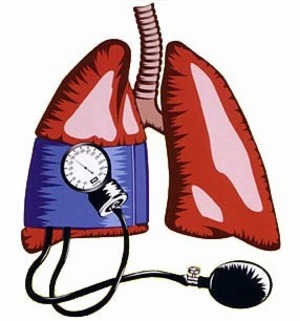Pulmonary Hypertension (PH) is high blood pressure in the arteries, lungs and right side of your heart. It begins when tiny arteries in your lungs, called pulmonary arteries and capillaries, become injured. This injury makes it hard for blood to flow through your lungs.
This condition raises the pressure in the vessels carrying blood to the lungs (pulmonary arteries). As the pressure builds, the part of the heart which pumps blood to the lungs (right ventricle) must work harder to pump blood. Over time this will cause the heart muscle to weaken and sometimes fail completely. This illness can be fatal.
This condition is classified as either primary or secondary PH.
When PH occurs without an underlying cause being identified, it is called primary PH. Primary PH is more common in young females. A positive family history is also a risk factor.
When a cause for the injury is found, it is called secondary PH. Secondary PH can be caused by diseases of the heart and the lungs. Some causes of secondary PH are chronic obstructive pulmonary disease (COPD) or emphysema, lung disease such as pulmonary fibrosis, a condition that causes scarring in the tissue between the lung’s air sacs, left side heart failure, sickle cell anemia, AIDS, lupus and cirrhosis of the liver.
Some other causes are blood clots from elsewhere which travel to the lungs an block the pulmonary arteries, scleroderma, long standing low blood oxygen levels, congenital heart disease and the use of diet medications. Some people with sleep apnea may develop this. This also happens in people living at high altitudes.
Symptoms can be shortness of breath, dizziness, fatigue, chest pain or pressure, fluid retention with swelling in your ankles and legs, bluish color of your lips and fingertips and rapid heart rate or palpitations.
Several test may be used to check for suspected PH can include a chest x-ray, a CAT scan and or an MRI, pulmonary function tests, an echocardiogram, genetic testing and sometimes a biopsy is taken of your lungs. A heart catheterization can be used to confirm the diagnosis.
It often takes time to find the best treatment for PH. The treatments are often complicated and require extensive follow-up care. Treatments may need changing when they are no longer effective. When PH is the result of another condition, the underlying causes is treated when possible. There are multiple medications to help this problem. Those prescribed medications can be based on your age and general health. In advanced PH, transplantation may be an option,
Always eat a well-balanced diet and get enough rest. Keep a healthy weight and stay as active as possible. Use any stress reduction activities you find useful. Avoid smoking or any medications that may affect your lungs. This would especially include street inhalants such as cocaine. Avoid using birth control pills, they contribute to blood clots, avoid high altitudes and stay out of hot tubs and saunas, they can lower your blood pressure.
Most complications are right side heart failure, blood clots, bleeding in the lungs and irregular heart.
Seek medical care if you develop shortness of breath or worsening of your condition, coughing up blood, develop chest pain, develop sudden swelling of your feet or legs or you have a sudden increase in weight.
For more information on PH visit the Pulmonary Hypertension Association at http://www.phassociation.org/.
Disclaimer: I am not a medical doctor and not affiliated with any medical school or organization. This information is not intended to be a substitute for professional medical advice. Always seek the advice of your physician or other qualified health professional prior to starting any new treatment or with any questions you may have regarding a medical condition. Nothing contained here is intended to be for medical diagnosis or treatment.



